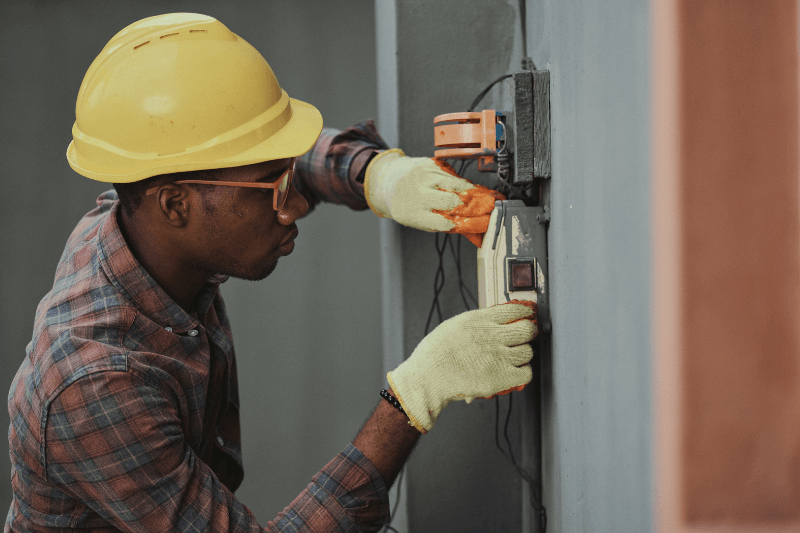
Lender-required repairs catch Many homeowners off guard when embarking on the home-buying journey. The real estate market has various nuances, and understanding the intricacies of these repairs can make a significant difference in your home purchase experience.
Often, these repairs are the crux between a homeowner and their dream house. With the guidance from Cream City Home Buyers, we aim to simplify this often confusing and intricate part of the process.
This article will delve deep into what these repairs are, examples of such repairs, and how best to navigate them. For homeowners, especially first-time home buyers, this knowledge can be invaluable, providing a more straightforward path toward securing your desired property.
What are Lender Required Repairs?
Lender-required repairs are conditions set forth by mortgage lenders to ensure a property’s soundness and safety before granting a loan. These requirements are primarily established to protect the lender’s investment in the property. In a way, it’s a mechanism to ensure that the real estate in question is worth the mortgage loan being offered.
The Federal Housing Administration (FHA) and conventional loan providers often have stringent requirements regarding the property’s condition. An appraisal report will be commissioned to inspect the home and ensure it adheres to the lender’s and possibly FHA’s property standards. The lender will require repairs if discrepancies are found during the home appraisal.
An FHA loan, in particular, focuses on ensuring the home is safe, sound, and secure for potential homeowners. The FHA is a part of the federal housing ecosystem, ensuring that loans are granted for homes in good condition, and free of health hazards and significant structural issues. However, these repairs are not exclusive to FHA loans. Conventional loans, USDA, and VA loans also have lender requirements.
Suppose you are considering taking a mortgage loan. In that case, it’s crucial to be prepared for these possible repair requirements, especially if the property is older or has visible wear and tear. The good news is, that services like Cream City Home Buyers can assist in understanding these nuances, ensuring you’re never caught unawares.
Lender Required Repairs Examples
As a homeowner or potential buyer, understanding the kind of repairs that might be mandated can be immensely beneficial. Some common lender-required repairs include:
- Structural Issues: Lenders prioritize the overall structural integrity of a property. Any signs of foundational problems, deteriorating roofs, or significant cracks can trigger repair requirements.
- Water Damage and HVAC: Leaky roofs or malfunctioning HVAC systems are prime candidates for lender-required repairs. Water damage can lead to many other issues, including mold, a health hazard. A fully functional HVAC system ensures the home’s comfort.
- Termite Infestations: These tiny pests can wreak havoc. An infestation is a major red flag for lenders, who typically require its complete eradication before approving a loan.
- Peeling Paint and Lead-Based Paint: For homes built before 1978, peeling paint can indicate the presence of lead, which poses severe health risks, especially for children. Lenders will demand that this issue be addressed promptly.
- Safety Concerns: Broken windows, malfunctioning water heater systems, or faulty electrical systems are immediate repair requirements. Anything that poses a direct threat to the homeowner’s safety needs rectification.
- Gutters and Crawl Spaces: Gutters must be in good condition, ensuring water is channeled away from the property. Crawl spaces, on the other hand, need to be free from standing water or pests.
When navigating these repair mandates, working with a knowledgeable realtor or a trusted entity like Cream City Home Buyers can help streamline the process. And if you’re in specific areas, services such as selling your house fast in New Berlin or we buy houses in Shorewood can be beneficial.
Understanding and anticipating lender-required repairs can ensure a smoother home purchase process, potentially saving time and money. Whether navigating code violations or ensuring a property’s market value, being prepared is the key.
What Happens When a Lender Requires Repairs
The home-buying process is full of anticipation and excitement, but occasionally, unexpected hurdles can occur. One such hiccup is when a lender stipulates repairs on a property before the loan is finalized. This requirement often arises from the home inspection or the appraisal report, which might indicate specific issues that the lender deems necessary to address for the safety and soundness of the home.
For instance, if a homeowner in New Berlin was hoping to sell their house fast, the realization that lender-required repairs need to be done can bring about unexpected delays. When the lender raises these concerns, the sale process might stall until the necessary repairs are completed. This is primarily because the lender’s primary goal is to ensure the collateral (the house) securing the mortgage loan retains its value.
The lender’s insistence on these repairs is rooted in the need to protect their investment. When major structural issues, water damage, or even termite infestations are detected, it can greatly reduce the house’s market value, leading to potential losses for both the lender and the homeowner.
This is especially crucial in locations where the real estate market is highly competitive. For instance, homeowners trying to navigate the Shorewood market would benefit from understanding how we buy houses in Shorewood services can aid in such situations.
Who Pays for Lender-required Repairs
The question of who foots the bill for lender-required repairs is a common point of contention in real estate negotiations. Generally, the responsibility can fall on either the buyer or the seller, depending on the terms negotiated in the purchase agreement.
In many scenarios, sellers are motivated to complete the necessary repairs to facilitate the sale. This is especially true if they aim for a specific sale price and want to avoid potential issues to lower the property’s market value.
Sellers might consider it a wise investment, especially if they want to achieve a fast sale. However, there are circumstances where the seller might need more support to cover the costs. In such cases, buyers might opt to handle the expenses, especially if they’re keen on securing the property.
This is often seen when buyers leverage resources like documents required to sell a house to understand the intricacies of the buying process.
There’s also a third option, where both parties negotiate and share the costs of repairs. This compromise can often expedite the sale process. Working with a seasoned real estate agent or entities like Cream City Home Buyers can give both parties insights on navigating this often tricky part of the home sale process.
Need To Sell Your House Fast?
We help you avoid lender-required repairs altogether.
Just fill out the form below or give us a call at: (414) 488-0082 to get your free, no-obligation cash offer!
Avoiding Lender-Required Repairs
In the world of real estate, time is often of the essence. Delays, especially those from lender-required repairs, can hinder the sale process and sometimes even jeopardize the deal. Fortunately, there are strategies homeowners can employ to sidestep these demands and ensure a smoother transition.
Firstly, before listing your property, conducting a preemptive home inspection is a good idea. This proactive step can highlight areas that might become contentious during the official inspection. Addressing these issues in advance reduces the risk of unwelcome surprises during the lending process.
Moreover, repairs related to health and safety, like fixing lead-based paint or structural defects, can be particularly concerning for lenders. Addressing these upfront can save considerable hassle down the line.
Another effective strategy is to engage in a cash sale. Cash buyers, such as certain real estate investment firms, often purchase properties “as-is.” This means they’re usually willing to overlook defects that traditional lenders might take issue with. Opting for a cash sale can eliminate the need for repairs and drastically speed up the selling process.
Lastly, consider the ramifications of potential issues. For example, if you’ve had fire damage repairs in your house, understanding the full extent of the damage and the cost of remediation can aid in negotiating with potential buyers or deciding the best way to market the property.
Do You Need to Do Lender-Required Repairs
Navigating the nuances of lender-required repairs can be a daunting task. A burning question many homeowners grapple with is whether these repairs are necessary. The straightforward answer? It depends.
When a lender requires certain repairs to be done, it’s typically because they want to ensure the value and safety of the property, which will act as collateral for the loan. If these requirements aren’t met, the lender could refuse to approve the mortgage. This makes the repairs seem indispensable.
However, the homeowner has a few potential routes. Firstly, they could negotiate with the lender. Sometimes, if the repair isn’t overly critical, a compromise could be reached where the lender may still approve the loan, especially if the borrower agrees to handle the repair shortly after the purchase.
Another option is to renegotiate the purchase price. If the buyer is willing, a reduced price might be agreed upon, reflecting the cost of the needed repairs. This can be particularly useful when dealing with significant concerns the seller can’t or won’t address before the sale.
Lastly, and perhaps most drastically, the homeowner can look for alternative financing. Different lenders have varying requirements; what one lender might flag as a necessary repair, another might overlook.
In conclusion, while lender-required repairs can seem like an insurmountable obstacle, understanding the reasoning behind them and exploring all available options can give homeowners the flexibility they need to navigate the situation successfully.

Conclusion
Navigating the intricacies of the real estate market is seldom straightforward, and lender-required repairs often add another layer of complexity. However, by understanding the nature and purpose of these requirements, homeowners can better prepare themselves for the challenges ahead.
Whether it’s preemptively addressing potential issues, negotiating with the lender, or seeking alternative financing routes, there are several strategies available to ensure a smooth transaction.
Moreover, the overarching goal remains the same: to ensure the safety and value of the property in question. As the homeowner, remember that while these repairs might seem burdensome, they are often in all parties’ best interest. By approaching the situation with knowledge, patience, and a willingness to explore all avenues, one can certainly navigate the path of selling or buying with greater ease and confidence.
